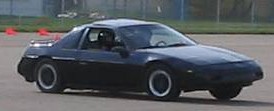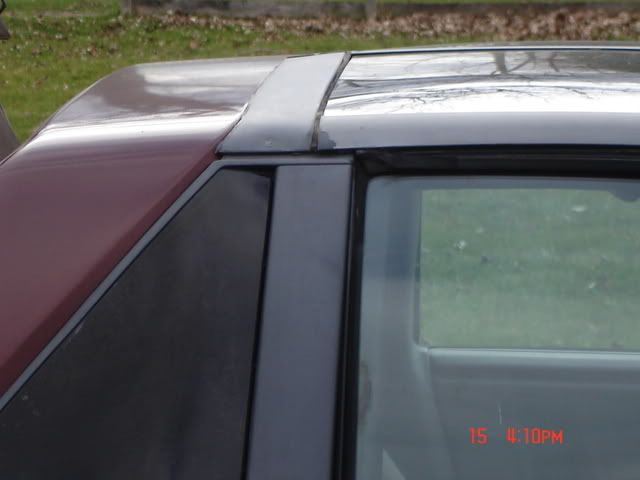| | | quote | Originally posted by Francis T:
well in way, it don't really matter that much, with the Fiero's undeserved rep, they will never be worth anywhere near what they should be, rare or not. but that does keep them cheep for us to buy |
|
Interesting article:
http://www.motortrend.com/f...919_80collectorcars/6 - Pontiac Fiero - The only North American mid-engine mass-produced automobile, and the only 2-seater ever produced by Pontiac. The lightweight, high strength plastic body construction was revolutionary. And it was the car that Ferris's sister Jeanie drove in one of the decade's top ten movies, "Ferris Bueller's Day Off." A well-preserved '84 Indy Pace Car is currently worth about $8,500.
Also:
FROM THE CAR CONNECTION DOT COM WEBSITE:
Twenty years ago, the now legendary and much-coveted
muscle cars of the 1960s and early 1970s - 289 "hi-po"
Mustangs, early Z28 Camaros, 389 GTOs - were just
tired old cars, common on seedy used car lots, and
well within the budget of most speed-hungry teenagers.
Fast-forward to the present, and most of those
machines have become rare and collectible rich men's
toys - $20,000 and up in most cases, with especially
desirable models such as the Shelby Mustangs (GT350
and GT500s) "big block" SS 396 and 454-equipped Chevy
Chevelles, the '73-'74 SD-455 Pontiac Trans Am, LT-1
Corvettes and 440 "Six Pack" (triple-carburetor)
Plymouth 'Cudas and Hemi Challengers selling for twice
that, sometimes a lot more.
Those who were smart (or just stupid lucky) bought
when these amazing cars were someone else's
second-hand gas pigs and redneck lawn décor, not
today's high-dollar classics.
Learn from the past!
The early and mid 1980s were another period when the
domestic automakers began making some neat cars again
- after almost a decade of bleakness that began with
the OPEC oil crisis and lasted through the end of the
Carter years.
Examples include the mid-engine, composite-bodied
Pontiac Fiero that was built from 1984 to 1988 (the
'84 Indy Pace car replicas are especially desirable;
ditto the later V-6 equipped GT and Formula models),
and the turbo 2.3 liter '84-'85 Ford SVO Mustang, a
four-cylinder hellion that was one of the very first
American cars to approach the performance question
with sophistication rather than brute force and also
one of the first U.S.-badged vehicles to wear
huge-for-the time 16x7-inch alloy rims shod with
50-series VR speed-rated (130-plus) "Gatorback"
ultra-performance tires. Its distinguishing
characteristics included an off-center hood scoop and
dual rear spoiler, plus a front end different from
other Mustangs, including the more conventional, V-8
equipped Mustang GT. The SVO Mustang was a good
performer, too, with 205 hp in its second year of
production - about as much as the GT's 4.9-liter V-8
was making at the same time.Both the Fiero and SVO
Mustang were unusual, almost experimental cars for
their respective automakers and are thus apt to become
valuable collectibles in the years to come.
The mid '80s also were the era of the very successful
1983-88 SS Monte Carlo - Chevrolet's last V-8 powered,
full-frame V-8 coupe. The SS Monte had the muscular
look of a Winston Cup stock car, and featured the
final appearance of a carbureted V-8 (Chevy's L69
5.0-liter "HO" engine) in a GM passenger car before
fuel injection took over (for emissions and fuel
economy reasons). Extra-rare "aerocoupes" were built
for just two years (1986-1987) and featured specially
contoured, wind-cheating back glass designed to give
the cars an aerodynamic advantage at high speed.
Around the same time, in 1983, Oldsmobile offered the
very last V-8 equipped, rear-drive Cutlass-based Olds
442 (and also the similar Hurst Olds in 1984). These
cars were also among the final run of rear-drive GM
vehicles to be powered by a non-Chevrolet V-8 (in this
case, Oldsmobile's venerable 307 cubic-inch/5.0-liter
V-8). The Hurst Olds featured a fearsome-looking (if
awkward to use) "Lightning Rod" Hurst shifter that was
its defining characteristic, plus a bulging hood
scoop, decklid spoiler and special paint and stripes.
Like the similar SS Monte Carlo, the Hurst Olds and
442 Cutlass were big, powerful American coupes of a
type that will never be made again. Hence, their
historic value is assured.
This brings us to the Buick Regal T-Type and the
sinister-looking Regal Grand National, the absolute
high water mark for '80s performance cars. Of all the
Reagan-era muscle coupes, these are the meanest. Grand
Nationals were painted all black (with the exception
of the introductory year 1982 models, which were
offered in silver and charcoal), and powered by
ever-more-potent versions of Buick's 3.8-liter
turbocharged V-6. By 1986, these ferocious rides
packed 235 hp, and could blast to 60 mph in under six
seconds - amazing performance for a coupe the size of
most of today's "full-size" sedans.
The last year of production, 1987, went out with a
bang. Before Buick (along with the rest of General
Motors) switched over to front-wheel drive for fuel
economy reasons, a final run of GNs and T-Types left
the factory, including 547 very special GNX models.
Regular Grand Nationals were shipped from the assembly
line to ASC/McLaren and fitted with a larger
turbocharger with low-drag impeller, a new Garrett
intercooler and revised low-backpressure exhaust
system to goose the output of the 3.8-liter engine to
a rated 270 hp and 360 lb-ft of torque. Since these
big, heavy cars ran the quarter mile in the mid-to-low
13s at more than 100 mph (as quick as a brand-new
350-hp 2003 Corvette), the official advertised
horsepower rating of 270 was almost certainly
underreported. GNX models are distinguished by their
fender flares, meaty wheels and tires, fender vents
and "GNX" badging. They're arguably the last true
American muscle cars in the tradition of the old GTOs
and SS Chevelles.
The mid-1980s were also a great time for
bread-and-butter performance machines such as the
4.9-liter "5.0" V-8 Mustang GT (and the more discrete
4.9-liter LX, which had the GT's engine, but not its
body cladding and trim) that were manufactured from
1982 until the early 1990s in more or less the same
basic form. Featuring Ford's tried-and-true 302 cubic
inch (4.9-liter) V-8 - the same basic engine that was
used in the very first Mustangs in the mid-1960s -
these cars offered affordable performance, were easy
to work on and benefited from a vast support network
of aftermarket parts suppliers and "speed shops" that
specialized in the traditional Ford small-block V-8.
Ford made so many "5.0" 'Stangs (the displacement
actually came in below 4950 cc, and thus the engines
were properly rounded to 4.9 liters) that it is still
a simple matter to locate a nice used one today for
less than $5000. Since Ford retired that V-8 shortly
after restyling the Mustang in 1994, the older cars
are destined to become interesting collectibles in the
coming years, limited-production models such as the
Cobra especially so.
1986 Chevrolet Camaro IROC-ZAlso of interest are the
'80s-era Chevy IROC-Z Camaro and its Pontiac cousins,
the Trans Am GTA and Formula Firebird. The later
(post-1985) models featured GM's "Tuned Port
Injection" (TPI) V-8s in either 5.0-liter or 5.7-liter
forms and racy body styles that were immensely popular
at the time. These "third generation" Camaros and
Firebirds far outsold the lackluster 1993-2002 cars
that were recently cancelled by General Motors -- and
there were a variety of low-production/special edition
models that will command a lot of money in the years
to come. These include the all-white 15th Anniversary
cars built in 1984 and the 20th Anniversary 1989
Trans-Am featuring the first-ever use of a V-6 engine
instead of a V-8 in a Trans Am. Pontiac fitted these
cars with the same basic 3.8-liter turbocharged V-6 as
used in the deceased Buick Regal Grand Nationals - and
this powerplant had the beans to whup its V-8-powered
competitors every time.
As the '80s ended and '90s began, GM also produced the
impressive (and very low production) GMC Typhoon and
later the Syclone - in 1991 and 1992, respectively -
which featured a 280-hp turbocharged 4.3-liter V-6
bolted to a full-time all-wheel-drive system. Capable
of sub-five-second 0 to 60 mph times, these monsters
were among the quickest and fastest vehicles available
then or now - and their low production and phenomenal
performance capability assures their future
collectibility.
Many of these "future classics" are merely old cars
today, just like the classic muscle cars of the '60s
and '70s once were. Most of them can still be found
in regular classified ads, and are generally
affordable (exceptions being the Grand National, the
GNX and the GMC Typhoon and Syclone, which are already
"hot" in the old-car market). That won't last, though.
As interest in these cars grows, and attrition
decreases the supply of "survivors," they'll become
increasingly harder to find - and more expensive, too.
Get them while you can!
[This message has been edited by tutnkmn (edited 03-04-2007).]


















 I would esitimate that less than 6000 Fieros, maybe a little more, still exist that are not in the scrap yards. Here in Missouri less than a 100 are in the clubs between St. Louis and K.C. and I don't know about other areas.
I would esitimate that less than 6000 Fieros, maybe a little more, still exist that are not in the scrap yards. Here in Missouri less than a 100 are in the clubs between St. Louis and K.C. and I don't know about other areas.











 I have the only radical widget in this part of the country, maybe this part of the world and yet, if no one else wants my radical widget, then it's only worth a personal value that I'll have to set myself.
I have the only radical widget in this part of the country, maybe this part of the world and yet, if no one else wants my radical widget, then it's only worth a personal value that I'll have to set myself.